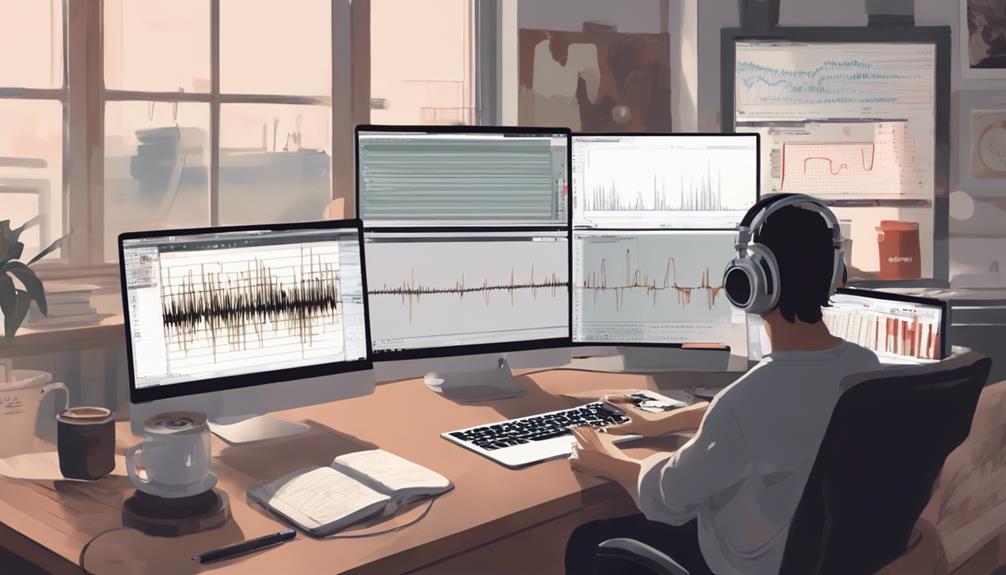Transcribing Vietnamese audio into text involves several key steps. First, gather essential tools like good headphones and a reliable transcription software. Next, prepare your audio files by ensuring high quality and organizing them neatly. Start by listening to the audio without pausing to get a sense of the content. Then, break the audio into smaller segments for easier transcription. Review your draft for accuracy and clarity, correcting any mistakes. Finally, format your text for readability and save your work properly. There's a lot more to explore in mastering this skill, so stick around for further insights!
Key Takeaways
- Familiarize yourself with Vietnamese dialects and accents to enhance comprehension during transcription.
- Use quality headphones and transcription software to improve audio clarity and playback control.
- Break audio into smaller segments for detailed listening and accurate transcription.
- Review and compare your transcript with the original audio to correct errors and ensure accuracy.
Understanding Audio Transcription

Audio transcription often involves converting spoken language into written text, making it a crucial skill in various fields. Whether you're in journalism, research, or content creation, understanding audio transcription can enhance your productivity. When you listen to audio recordings, you're not just hearing words; you're capturing nuances, tone, and inflection that can change the meaning.
To get started, familiarize yourself with the context of the audio. Knowing the subject matter helps you understand the content better, allowing for more accurate transcription. As you listen, focus on capturing the speaker's intent. This means paying attention to pauses, emphasis, and jargon specific to the topic or culture.
You'll also want to develop your listening skills. Practice active listening by minimizing distractions and concentrating fully on the audio. This sharpens your ability to pick up on details that matter. Additionally, it's essential to remain neutral and objective, avoiding personal opinions about the content. By honing these skills, you'll find that audio transcription becomes more intuitive, enabling you to produce high-quality written material from spoken sources efficiently.
Essential Tools for Transcription
To effectively transcribe spoken content, you'll need a few essential tools that streamline the process and enhance accuracy. First, invest in a reliable pair of headphones. Good headphones help you catch every word clearly, minimizing distractions from background noise.
Next, consider using transcription software or applications. These tools can significantly speed up your work by allowing you to control playback speed, rewind, and pause easily. Popular options include Express Scribe and Otter.ai, which also offer features like voice recognition.
You'll also want a comfortable keyboard. Whether you prefer a traditional keyboard or a mechanical one, ensure it's responsive for typing quickly and accurately. For those who may not want to type everything manually, a foot pedal could be invaluable. It lets you control audio playback with your foot, freeing up your hands for typing.
Lastly, keep a style guide handy. This ensures consistency in your transcriptions, especially when it comes to punctuation, abbreviations, and formatting. With these tools, you'll find the transcription process smoother and more efficient, leading to higher-quality results.
Preparing Your Audio Files

Ensuring your audio files are clear and well-organized is crucial for a smooth transcription process. Start by selecting high-quality recordings; background noise can make understanding difficult. If possible, use a good microphone and record in a quiet environment to enhance audio clarity.
Next, check the format of your files. Common formats like MP3 or WAV are preferred for compatibility with transcription software. If your recordings are in a less common format, consider converting them before you begin.
Organize your files systematically. Create a dedicated folder for your project and label each audio file clearly, including dates and any relevant context. This'll save you time when you need to reference specific recordings.
If you have multiple speakers, consider adding a note identifying them, as this can help during the transcription process. Lastly, listen to each audio file briefly to ensure there are no issues like distortion or abrupt cuts. Address these problems before starting the transcription. By taking these steps, you'll set yourself up for effective and efficient transcription of your Vietnamese audio files.
Listening Techniques for Accuracy
Mastering effective listening techniques is vital for achieving accurate transcription of Vietnamese audio. Start by familiarizing yourself with the speaker's accent and dialect, as this can significantly impact your understanding. If possible, listen to samples from various speakers to train your ear.
Next, break the audio into manageable segments. Instead of trying to transcribe large portions at once, focus on shorter clips. This allows you to concentrate on each word and phrase, reducing the chances of missing key details.
Use playback tools that allow you to control the speed of the audio. Slowing down the playback can help you catch nuances and tricky phrases that you might otherwise overlook. Don't hesitate to pause frequently; this gives you time to process what you've heard and jot down notes.
It's also helpful to listen multiple times. During the first listen, get a general sense of the content. On subsequent listens, focus on specific details and clarify any unclear sections. By employing these techniques, you'll improve your accuracy and efficiency in transcribing Vietnamese audio, making the process much smoother.
Step-by-Step Transcription Process

Building on effective listening techniques, the step-by-step transcription process can help you convert Vietnamese audio into text with greater accuracy and efficiency. Start by gathering your tools: a good quality headset, a reliable audio player, and a text editor.
Listen to the audio once without pausing. This gives you a sense of the content and flow. Next, rewind and play the audio in shorter segments. As you listen, type what you hear. Don't worry about perfection; focus on getting the words down.
After you've transcribed the first draft, listen to the audio again for clarification. Compare your text against the audio, correcting any errors or misheard phrases. Pay attention to context, as it can help you decipher words that might sound similar.
Once you've made your corrections, read through your transcription to ensure it flows naturally and makes sense. Finally, save your document in a secure format and back it up. By following these steps, you'll transform Vietnamese audio into a clear and accurate text representation. Happy transcribing!
Tips for Handling Difficult Dialects
When tackling difficult Vietnamese dialects, it's crucial to familiarize yourself with the unique sounds and expressions that may differ from standard Vietnamese. Start by listening to audio samples from various regions, like Northern, Central, and Southern Vietnam. The more exposure you get, the better you'll understand the nuances.
Next, pay attention to intonation and rhythm. Some dialects might use different tones, which can change the meaning of words entirely. Practice mimicking these sounds to help your ear adapt. It's also helpful to engage with native speakers or dialect coaches who can provide insights into specific phrases or idioms that are common in certain areas.
Don't shy away from using resources like dictionaries or online forums dedicated to Vietnamese dialects. They can be invaluable when you encounter unfamiliar vocabulary. Additionally, note any local slang or colloquial terms, as these can be essential for accurate transcription.
Editing and Proofreading Your Transcript

After you've tackled the challenges of difficult dialects, the next step is to focus on editing and proofreading your transcript for accuracy and clarity. Start by reading through your transcript carefully, comparing it with the original audio. This helps you catch any missed words or phrases. Pay attention to the nuances of the Vietnamese language; slight misinterpretations can change the meaning.
As you review, check for grammar, punctuation, and spelling errors. It's essential to maintain the integrity of the original message while ensuring it's easily understood. If you're unsure about a specific word or phrase, refer back to the audio for confirmation.
Next, consider the flow of the text. Sentences should be coherent and logically structured. If something sounds awkward, rephrase it for better clarity. You might also want to read the transcript aloud; this can help you identify any awkward phrasing or errors you might have missed.
Formatting Your Transcribed Text
Properly formatting your transcribed text is crucial for enhancing readability and ensuring the content flows smoothly. Start by breaking your text into clear paragraphs. Each paragraph should focus on a single idea or theme, making it easier for readers to follow along. Use headings and subheadings to organize sections, especially if your transcript covers multiple topics.
Next, consider using bullet points or numbered lists for important information or steps. This visual organization helps highlight key details and makes the content more digestible.
Pay attention to font size and style; choose a readable font like Arial or Times New Roman, and maintain a consistent size throughout. Don't forget about spacing—adequate line spacing improves readability, so opt for at least 1.5 line spacing.
Finalizing and Saving Your Work

To ensure your transcription is complete and ready for use, take a moment to review the text for any errors or inconsistencies before saving your work. Read through the transcription carefully, checking for typos, grammatical mistakes, and any missed words. Listening to the audio again while following the text can help catch anything you might've overlooked.
Once you're satisfied with the accuracy, consider formatting your document for clarity. Use bullet points, headings, or timestamps where necessary. This makes it easier to navigate later, especially if you or someone else will refer back to it.
After finalizing your text, it's time to save your work. Choose a descriptive file name that reflects the content, such as “Vietnamese_Interview_Transcript_Date.” It's also wise to save your document in multiple formats, like .docx and .pdf, to ensure compatibility across different platforms.
